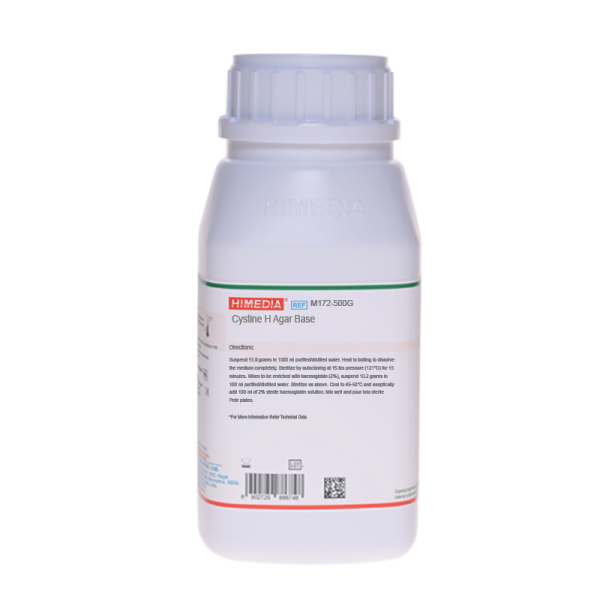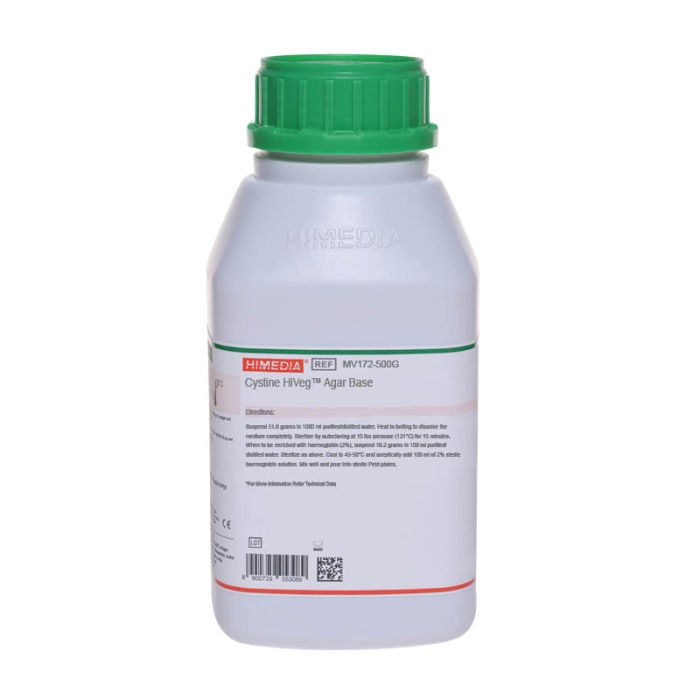 Your enquiry has been submitted
Your enquiry has been submitted
Cystine Heart Agar Base (Revised as Cystine H Agar Base)
Intended use
Recommended for the cultivation of Francisella tularensis with enrichment with haemoglobin, without enrichment it supports excellent growth of gram-negative cocci and other pathogenic organisms.
Composition**
| Ingredients | g / L |
|---|---|
| HM infusion solids B∆# | 10.000 |
| Proteose peptone | 10.000 |
| Dextrose | 10.000 |
| Sodium chloride | 5.000 |
| L-Cystine | 1.000 |
| Agar | 15.000 |
Final pH ( at 25°C): 6.8±0.2
**Formula adjusted, standardized to suit performance parameters
∆# -Equivalent to Beef heart infusion (solids)
Directions
Suspend 51.0 grams in 1000 ml purified/ distilled water. Heat to boiling to dissolve the medium completely. Sterilize by autoclaving at 15 lbs pressure (121°C) for 15 minutes. When to be enriched with haemoglobin (2%), suspend 10.2 grams of medium in 100 ml distilled water. Sterilize as above. Cool medium to 45-50°C and aseptically add 100 ml of 2% sterile haemoglobin solution. Mix well and pour into sterile Petri plates.
Principle And Interpretation
Francisella tularensis is the cause of tularaemia, a plague-like disease of rodents and other small organisms. It was first described in humans in 1907 (1). The organisms are strict aerobes; fresh isolates cannot be cultured on ordinary medium but require a complex medium containing blood, or tissue extracts and cystine. Several media formulations were employed to isolate this microorganism. Blood Dextrose Cystine Agar, described by Francis (2) was found to be satisfactory for cultivating F. tularensis. Addition of 0.05% cystine and 1% dextrose to Heart Infusion Agar can also be employed for cultivation of F. tularensis (3). Subsequently haemoglobin was added to Cystine Heart Agar Base to develop a satisfactory cultivation medium for F. tularensis (4). This medium is also known as Cystine Glucose Blood Agar and is the most suitable medium for isolating F. tularensis (2). Hemoglobin provides additional nutrients and growth factors. This medium also supports growth of gram-negative cocci and other pathogenic microorganisms without additional enrichment. Cystine Heart Agar Base can be supplemented with Rabbit blood and antimicrobial agents (4). This medium is a nutritionally rich medium, which may also be used for cultivating many other organisms generally difficult to grow.
HM infusion solids B and proteose peptone are sources of carbon, nitrogen, vitamins and minerals. Dextrose is an energy source. L-Cystine is the source of amino acid. Sodium chloride provides the essential ions. Overgrowth by contaminating organisms can be reduced by incorporating 100-500 units penicillin per ml into the medium (1). F. tularensis is a Biosafety Level 2 pathogen that can be transmitted by aerosols or by penetration of unbroken skin (5). Wearing of gowns, gloves and masks is recommended for people handling suspected infectious material (5).
Type of specimen
Clinical samples - Enriched sample from broth medium
Specimen Collection and Handling
For clinical samples follow appropriate techniques for handling specimens as per established guidelines (6,7). After use, contaminated materials must be sterilized by autoclaving before discarding.
Warning and Precautions
In Vitro diagnostic Use only. For professional use only. Read the label before opening the container. Wear protective gloves/ protective clothing/eye protection/ face protection. Follow good microbiological lab practices while handling specimens and culture. Standard precautions as per established guidelines should be followed while handling clinical specimens.
Limitations
- Further biochemical and serological tests must be carried out for further identification.
- Individual organisms differ in their growth requirement and may show variable growth patterns on the medium.
- Each lot of the medium has been tested for the organisms specified on the COA. It is recommended to users to validate the medium for any specific microorganism other than mentioned in the COA based on the user’s unique requirement.
Performance and Evaluation
Performance of the medium is expected when used as per the direction on the label within the expiry period when stored at recommended temperature.
Quality Control
Appearance: Cream to yellow homogeneous free flowing powder
Gelling: Firm, comparable with 1.5% Agar gel
Colour and Clarity of prepared medium: Basal medium: Amber coloured clear to slightly opalescent gel. After addition of 2% haemoglobin solution: Chocolate brown coloured opaque gel forms in Petri plates
Reaction: Reaction of 5.1% w/v aqueous solution at 25°C. pH : 6.8±0.2
pH: 6.60-7.00
Cultural Response: Cultural characteristics observed with added 2% Haemoglobin after an incubation at 35-37°C for 40-48 hours.
| Organism | Growth |
|---|---|
| Francisella tularensis ATCC 29684 | luxuriant |
| Neisseria meningitidis ATCC 13090 | luxuriant |
| Streptococcus pneumoniae ATCC 6303 | luxuriant |
| Streptococcus pyogenes ATCC 19615 | luxuriant |
Storage and Shelf Life
Store between 10-30°C in a tightly closed container and the prepared medium at 2-8°C. Use before expiry date on the label. On opening, product should be properly stored dry, after tightly capping the bottle in order to prevent lump formation due to the hygroscopic nature of the product. Improper storage of the product may lead to lump formation. Store in dry ventilated area protected from extremes of temperature and sources of ignition Seal the container tightly after use. Product performance is best if used within stated expiry period.
Disposal
User must ensure safe disposal by autoclaving and/or incineration of used or unusable preparations of this product. Follow established laboratory procedures in disposing of infectious materials and material that comes into contact with clinical sample must be decontaminated and disposed of in accordance with current laboratory techniques (6,7).
Reference
- Murray P. R., Baron J. H., Pfaller M. A., Jorgensen J. H. and Tenover F. C., Yolken R. H., (Ed.), 1999, Manual of Clinical Microbiology, 7th Ed. American Society for Microbiology, Washington, D.C.
- Francis, 1928, JAMA, 91:1155.
- Shaw, 1930, Zentr. Bakt. I. Abt. Orig., 118:216.
- Rhamy, 1933, Am. J. Clin. Pathol., 3:121.
- U.S. Public Health Service, Centers for Disease Control and Prevention, and National Institutes of Health, 1999, Biosafety in Microbiological and Biomedical Laboratories, 4th Ed., HHS Publication.
- Isenberg, (Ed.), 1992, Clinical Microbiology Procedures Handbook, Vol. 1. American Society for Microbiology, Washington, D.C.
- Jorgensen, J.H., Pfaller, M.A., Carroll, K.C., Funke, G., Landry, M.L., Richter, S.S and Warnock., D.W. (2015) Manual of Clinical Microbiology, 11th Edition. Vol. 1.
| Product Name | Cystine Heart Agar Base (Revised as Cystine H Agar Base) |
|---|---|
| SKU | M172 |
| Product Type | Regular |
| Physical Form | Powder |
| Origin | Animal |
| Packaging type | HDPE |
| References | 1.Francis, 1928, JAMA, 91:1155. 2.Isenberg, (Ed.), 1992, Clinical Microbiology Procedures Handbook, Vol. 1. American Society for Microbiology, Washington, D.C. 3.Jorgensen,J.H., Pfaller, M.A., Carroll, K.C., Funke, G., Landry, M.L., Richter, S.S and Warnock., D.W. (2015) Manual of Clinical Microbiology, 11th Edition. Vol. 1. 4.Murray P. R., Baron J. H., Pfaller M. A., Jorgensen J. H. and Tenover F. C., Yolken R. H., (Ed.), 1999, Manual of Clinical Microbiology, 7th Ed. American Society for Microbiology, Washington, D.C 5.Rhamy, 1933, Am. J. Clin. Pathol., 3:121. 6.Shaw, 1930, Zentr. Bakt. I. Abt. Orig., 118:21 6. 7.U.S. Public Health Service, Centers for Disease Control and Prevention, and National Institutes of Health, 1999, Biosafety in Microbiological and Biomedical Laboratories, 4th Ed., HHS Publication. |
| Customized Product Available | No |





